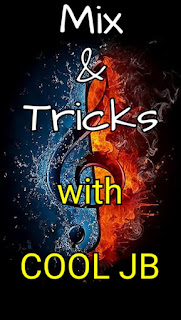⏱️Music Education: MIX AND TRICKS WITH COOL JB 1
8 TECHNIQUES THAT WILL TRANSFORM YOUR AFROPOP INSTRUMENTALS
With every day that breaks, afrobeat is constantly garnering popular appeal both locally and internationally. That said, it becomes needful to bring to mind the ever rising demands on music producers to be able to spin out great sounding afropop instrumentals, if they must stay relevant in the "game".
Below are 8 beatmaking techniques every Nigerian producers must have in their bag of tricks. These techniques/tips will immediately transcend your sound into the realm of the "highly-spiritual".
1. PERCS PLEASE!!!
Afrobeat is characterized by its highly percussive sound. Playing around with percussion samples is essential to finding that hidden bounce. Most afrobeat vibes feature sounds from diverse cultural backgrounds, from africa (djembes, Bongo, agogo etc.) to the carribeans ( maracas, cabasa, conga etc), to asia (dulcimer, shamisen, koto etc.)
Don't be afraid to infuse percussive elements from various genres and styles. This cross-mixing is key to getting that organic afrobeat sound.
However, it is important to know (by ear) when the percussion is getting too heavy for comfort, as a clumsy percussion line could busy up the music and collide with the artist's vibe. Finding the right balance between a sweetly thick percussion line and a disturbingly congested one, comes by practice and "well accustomed" ears.
2. SHAKE IT OFF!!!
Having discussed percussions, it might have been needless to talk again of shakers, but for the high priority role they play. The organic african Shaker sample is a salient part of the afrobeat/afropop sound. It immediately transforms an otherwise static drum pattern into upbeat driving groove.
However, note that the shaker is to be used to play a fixed rhythmic pattern which almost never changes. The interplay between this fixed "timeline" pattern and other rhythmic elements, creates what is known as polyrhythm. This is a highly desirable effect in your percussion lines, trust me.
As a quick expo, great shaker patterns always play few notes in a repeated fashion, with spaces that allow the beat to "breath", thereby creating a sense of relaxedness.
3 A WORD ON CHORDS!!!
chords set the overall emotional atmosphere for the music. The crazier part of this is that afrobeat expects you to create an inviting emotional atmosphere with as few as two chords!!!!! (Who does that???) Well, afrobeat musicians over the ages have done that, time and time again!!!
The secret here is to understand chords and how they function. Minor chords have a gloomy sound, whereas major chords project a merry mood. Finding the right balance (for each song) is key. Too many minor chords and you end up with a dirge. On the other hand, too many major chords and you have for yourself a Nursery rhyme. (Not too bad if that's what you wanted afterall!!)
To do justice with chords, understand the song you're working with, and create its intended emotional scene, using a perfect blend of major and minor chords. Also, deal with extended chords with a ton of carefulness. Extended chords are chords beyond the 7th chord. I.e., the 9th, 11th and 13th chords. Use them when you want to take afrobeat out of this world, AT YOUR OWN RISK!!!!!!!!! (I warned you!!)
The next topic complements this one. DON'T SKIP.
4. VOICES ARE EVERYTHING!!!
It is your job, as an afrobeat producer, to understand the peculiarities and specialties of instrument (or synth) voices. Sometimes, all you need to tighten up a floppy vibe is to make the best choices on what voices to use for your beat elements (pads, basslines, lead parts etc.) To be sure I'm telling the truth, you could go to one of the beats you made, and change any of the voices (e.g., a piano voice to a mute guitar) and notice how the entire sound is transformed into something totally different. The reality of voice selection being very key to getting a great afrobeat sound, gives you the task of consciously learning and mastering the art "using" voices (some call this "orchestration".)
This task is a two-faced one at least. Asides being able to recognize and appreciate each synth or musical instrument's "voice" and best use,
You must know how to find them in your tone-generating plugins. This comes by understanding the classifications of musical instruments (acoustic, electronic and computer-created).
Expressions such as "woodwind" "brass" "strings" "acoustic piano" "electric piano" etc, are frequently encountered within the interface of tone generators (such as purity and hypersonic.) You could google these words for indepth explanation but, as a quick expo, I'll give you a few go-to voices that come in very handy and useful in afrobeat situations. Enclosed in brackets are the categories in which you'll find them on regular tone generators.
E. Ps (Electric piano), Pan flute (Woodwinds), Brass section (Brass), Deep sub-basses (Synth bass), Distorted guitar (Electric guitar), Muted guitar (Electric guitar), Pads (Slow synths, pads). This list is just a few of the endless voices that exist. However, the key is not to know all the voices that exist, but to know the ones that are relevant to afrobeat (sometimes based on trend), and to know how to locate them in any tone-generating plugin.
5. ROLL YOUR BOAT!!!!
Because afrobeat music is largely simplistic, it is important to introduce momentary highpoints to avoid monotony . One great way to do this is to introduce drum rolls.
Afrobeat drum rolls serve as well to distinguish sections as to provide an extra peak in the groove. Very dynamic in nature, they are meant to take the listener by shock and surprise. However simple, drum rolls must reignite listener's interest. This they must do by coming in unexpectedly, and by having in them elements that are in sharp contrast to the already established pattern (among many other roles.)
For example, in a soft section within an instrumental, an effective drum roll might be a sudden loud (short) passage. Or, you can have the elements (patches) of the drum roll panned harder to the left or right, than any other element in the entire beat. This will immediately set it apart and make it more effective as a live wire.
Note, however, that most contemporary afrobeat drum rolls are not built from a conventional drums setup (kick, toms, hihat, crash etc.) Modern drum rolls could just be an 808 snare or rimshot playing a very interesting "chopped-notes" pattern while quicky rising in volume.
So, you don't have to break your head with the intricacies of real drumming.
Furthermore, be sure to experiment with effects such as reverb, delay, panning, filter automation, velocity ramps etc.
Lest I forget, a very sharp, wet clap on the downbeat (beat 1) works well!!!
6. GET THINGS STRAIGHT.
Nobody enjoys a piece of music which parts do not cohere properly. Nobody wants to have to listen to a piece of music five million times to be able to tell which part is the chorus and which part is the verse.
Therefore, it is pertinent to arrange the music to be the clearest it can. Use a lead synth line, for example, in the verses to tell them apart from the hook. Mute the percussions in the hook, and play the synth bass only in the chorus (all these are examples.)
Simply put, do all it takes to make the parts/sections clearly marked out. It makes the music sound perfect!!! This is called ARRANGEMENT.
Another aspect of good arrangement is ensuring that everything in the beat happens in a calculated manner. E.g., Let the drum rolls come in every 16 bars (a bar is four counts), or the vocal fx sample every 8 bars. The pattern of the music must be well decided to prevent an overall randomness and confusion.
Finally, an over predicable music is not something you want either. The minds of certain advanced listeners can easily master the patterns within the music, leading the music to become too predictable and uninteresting to them. You can avoid this by introducing contrasts at certain points. Such contrast could be an unprecedented silence (e.g., for half a bar,) muting the kick at a point, a unique bassline in one of the chorus sections, an extra percussion line, etc., the list is endless. These sudden breaks in the pattern act as suspense, just like in a Chuck Norris movie.
7. SWING IT!!!!!
This knob is an unsung hero in the User Interfaces of many DAWS. I suppose this is due to this knob's involvement in sorcery and dark magic!! You would agree with me, but not before you turn it halfway up.
The swing function is one function that transfoms an otherwise mundane drumline into a highly modern-sounding groove. This tool is tried and true in making any kind of groove sound jumpy, upbeat and ready to be danced to. Experiment with this feature in your DAW. Start with 30-40% swing. Sometimes you'll need a whooping 50% swing, but i never advice anything above that. Make 50% your upper limit as anything above that will readily swing your drumline out of earth.
8. BEND DOWN SELECT!!!
What I'm about to discuss is probably one of the most overlooked part of afrobeat production by many rising producers. It is the issue of carefully selecting your patches before carrying on with the beatmaking process. This is due to the myth that mixing will "resolve all issues", like an antivirus software.
This is highly untrue. If the patches are bad, the mix will turn out manageable at best. It's best practice to carefully choose patches from scratch, making sure that each patch already sounds very close to what you expect to hear eventually. Don't think that mixing can fix a sloppy kick and make it sound punchy and fat and deep and grammy!!! Simply pick a punchy and fat and deep kick from the scratch!!! Take your time. Go through your sample library, listening to every sonic detail, and ensuring that the patches you choose match the ones in your head. Afterall, that's where it all starts- in your head!!!
If, per adventure, you find a sample you like and you feel it'll only take a little tweaking to get it sounding the way you want, do that tweaking first to ensure the sample can ever get to sound the way you want it to. Sometimes, a little tweaking is equal to four hours of futile adjustments.....that won't eventually nail it.
Note that every sample you dream of actually exists. The more beautiful part is knowing that you'll find samples that sound like your ultimate dream samples, without a single adjustment. So take your time to get samples. From friends, enemies and every other source available to you.
There you have it!!! We hope these tips work for you (they did for me and thousands of other people). Keep practicing and keep growing.
You can forward any questions or comments via this platform or to the author.
CoolJB,
music producer, mixing and mastering engineer.
Call:
+234(0)7087768613
Instagram:
@theonlycooljb.
Email:
theonlycooljb@gmail.com
Blog Spot Contact:
Twitter: @tpmafrica
Facebook: Truth Perspective Media
Email: truthperspectivemedia@gmail.com
WhatsApp: +234(0)8163157140















awesome!!
ReplyDeletei love this, so much details to learn
Very insightful
ReplyDelete